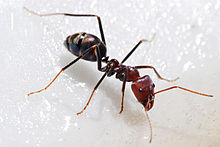Iridomyrmex
| Iridomyrmex | |
|---|---|

| |
| Meat ant (I. purpureus) | |
| Scientific classification | |
| Kingdom: | |
| Phylum: | |
| Class: | |
| Order: | |
| Family: | |
| Subfamily: | |
| Tribe: | |
| Genus: | Iridomyrmex Mayr, 1862
|
| Species | |
|
see text. | |
Iridomyrmex is a genus of ants that belongs to the subfamily Dolichoderinae. There are 79 species and subspecies that belong to this genus and they range from India to China to Australia and New Caledonia.
Description
Unlike other genera in Dolichoderinae, Iridomyrmex ants have the front margin of the clypeus above the mandibles highly modified with convex areas towards the sides and a central projection, which varies from strongly to weakly developed. The compound eyes are relatively high on the head and away from the mandibles.
Behaviour
Iridomyrmex ants are generally aggressive to other ants. They form large nests (from several hundred to over 300,000 workers), which limits the number of competing nests that can be formed in a given area. Oftentimes, the only neighbouring ant species that can co-exist are those that are of different size or those that forage for food at different times, thus limiting contact with the Iridomyrmex ants. They can be territorial even with ants of their own species but from different nests.
Nests may be above or below ground, with some species such as I. conifer alternating between the two. Meat ants (I. purpureus) are known to create "super-colonies" of many small nests that are connected together, reaching as large as 650 metres in length.
Feeding
Iridomyrmex ants are generally scavengers. Workers of some species will form "highways" to food sources, while workers of other species forage singly. Iridomyrmex are particularly attracted to seeds with elaiosomes. They will collect these seeds and remove the elaiosomes, discarding the seeds afterwards. The seedlings that sprout from these seeds benefit from the aggressiveness of the Iridomyrmex ants, giving them a better chance of survival.
Caterpillars of certain butterfly species produce secretions that Iridomyrmex ants will feed on. In extreme cases, the ants will carry the caterpillar back to their nests where they will protect it. These ants may also tend to aphids and coccids, collecting nectar when possible.
Predators
Some invertebrate species specialise in predation of Iridomyrmex ants. There are species of spiders that can detect the ants' chemical communications and selectively target injured members. Ground beetles also have been known to create burrows near ant nests and prey on passing workers.
Species
- I. agilis
- I. albitarsus
- I. anceps
- I. anderseni
- I. anteroinclinus
- I. argutus
- I. bicknelli
- I. bicknelli azureus
- I. bicknelli brunneus
- I. bicknelli luteus
- I. bicknelli splendidus
- I. bigi
- I. cappoinclinus
- I. cephaloinclinus
- I. chasei
- I. chasei concolor
- I. chasei yalgooensis
- I. conifer
- I. cyaneus
- I. discors
- I. dromus
- I. emeryi
- I. exsanguis
- I. galbanus
- I. gracilis
- I. gracilis fusciventris
- I. gracilis mayri
- I. gracilis minor
- I. gracilis rubriceps
- I. gracilis spurcus
- I. greensladei
- I. hartmeyeri
- I. hesperus
- I. innocens
- I. lividus
- I. mattiroloi
- I. mattiroloi continentis
- I. mattiroloi parcens
- I. mattiroloi splendens
- I. mimulus
- I. mjobergi
- I. notialis
- I. obscurior
- I. obscurus
- I. occiduus
- I. prismatis
- I. purpureus
- I. reburrus
- I. rufoinclinus
- I. rufoniger
- I. rufoniger domesticus
- I. rufoniger incertus
- I. rufoniger pallidus
- I. rufoniger septentrionalis
- I. rufoniger suchieri
- I. rufoniger victorianus
- I. sanguineus
- I. spadius
- I. spodipilus
- I. variscapus
- I. vicinus
- I. viridiaeneus
- I. viridigaster
References
- "Genus Iridomyrmex". CSIRO Entomology. Retrieved 2007-04-10.
